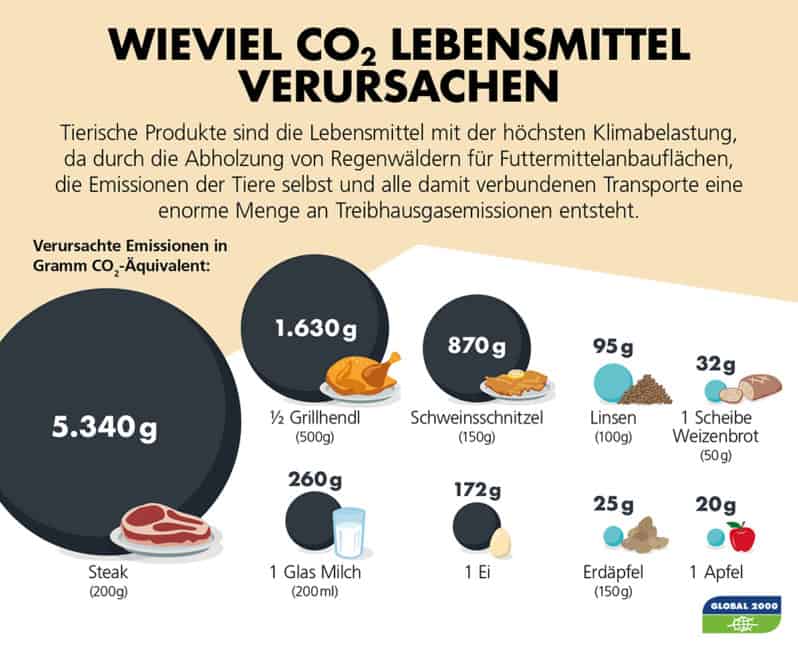At the beginning of the 19th century, meat consumption worldwide was ten kilograms per person per year. Since then it has risen continuously: in the 1960s to more than double. Today we have reached 40 kilos per head. Global meat production has quadrupled over the past 60 years, and the trend is rising, according to the figures from Global 2000. This is accompanied by some problematic developments: Meat has a comparatively poor ecological footprint, because the animal feed requires a lot of water and acreage become.

Feed factor
“It makes sense when animals feed on grasses that cannot be used by the human stomach. But only a small part (about 15 - 20 percent) of Austrian cattle can graze on pastures. The main problem is the dependence on feed that cannot be grown in Austria in the required quantity. Austria is the fifth largest soybean country in the European Union with around 44.000 hectares, but this amount is far from sufficient to satisfy the hunger of domestic farm animals. Between 550.000 and 600.000 tons of genetically modified soy are imported every year (around 70 kilograms per Austrian), for which the majority of the South American rainforest had to be cleared, ”he says Global 2000 to the point.
What many do not know: Even the AMA seal of approval allows genetically modified feed. The good news is that an alternative is already being researched. In a new research project entitled "FLOY", Global 2000 is working with research partners to investigate whether the larvae of the black soldier fly are suitable as regional feed for chickens, pigs and fish. The aim of the project is to produce a sustainable protein feed in Austria in line with the circular economy. The project is still in the test phase, but with the new feed, the ecological footprint of meat could be significantly improved.
Because of species-appropriate
Another argument against meat consumption is of course that animal welfare. Because factory farming is still a common form of farming. Different seals of approval promise a species-appropriate attitude, but a case that was recently uncovered in Baden-Württemberg shows that it is not always reliable. Here a pig fattener with seal from the animal welfare initiative let his animals go into disrepair and was tortured severely (option reported).
This may not be the rule, but especially when it comes to very cheap offers, special attention must be paid to the origin of the meat. “The dose makes the poison, it is said, and with regard to the ecological footprint that probably applies here too. Excessive meat consumption poses problems for the ecology and human health. The situation is different with animal welfare. Few animals can also be kept poorly. Therefore, a new perspective or a different perspective is needed in livestock farming. The price and the amount of meat must not be used as a measure, but the welfare of the animals must come first. And here the welfare of the animals must be measured in such a way that it meets the needs of the animals. The needs that an animal naturally has - primary needs, ”says organic farmer Norbert Hackl, owner of the Labonca organic farm.
The country needs real animal rights
And although Austria has one of the strictest animal welfare laws in Europe, the need for improvement is still enormous, Hackl is convinced: “The animal welfare law and the livestock ordinance strongly contradict each other. According to the Animal Welfare Act, every animal should be kept "appropriately". According to the Livestock Ordinance, standards are allowed that have nothing to do with animal welfare, but contain purely economic aspects: fully slatted floors instead of outdoors, 20 weeks of individual cage breeding per year instead of group housing and farrowing outdoors are examples.
Either society manages to become aware that our meat consumption as well as meat from Austrian factory farming stands for enormous animal suffering and is also unhealthy for people (antibiotic resistance, etc.) or the legislator regulates and specifies how animals are "actually kept in a species-appropriate manner" Need to become. Then meat costs a lot more. That's why nobody will starve. ”Basically, the pig farmer, who was the first farmer to win the Austrian Animal Welfare Award in 2010, is convinced:“ Meat has to be a side dish! ”Or we'll only eat in the future Art meat.
The reports on the consequences of our meat consumption and industry on animals Association against animal factories VGT.
Photo / Video: Shutterstock.



